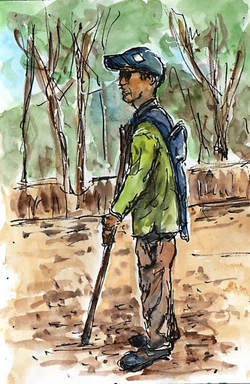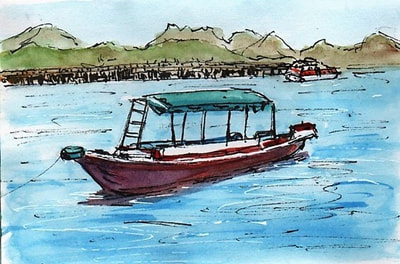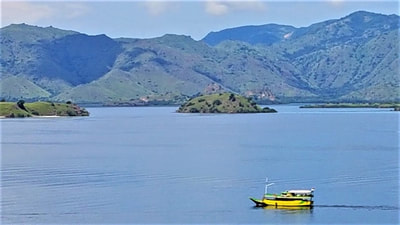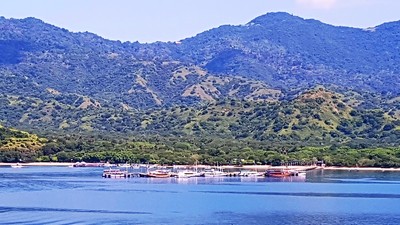|
One thing we love about cruises is when you wake up in a new place. We had researched Komodo but all that is really mentioned is the Komodo dragon. Stepping onto the deck, we were greeted with a stunning vista of islands and seascape. This surprised us and we decided to walk around the ship to take in the fantastic views. On top of one of the mountains, the trees looked like a row of lollipops This was the first sketch I decided to do. Small boats were crossing the calm sea, taking people from Komodo to other Islands and the whole scene was one of peacefulness.  When doing our research,we read that it wasn't always worth going on a trip to see the dragons, as they often wandered near the beach and you could see them on the shoreline. However, we were informed on the ship, before we arrived at Komodo, that no one was allowed ashore unless on an official tour, as the island was a National Park. You could organise a trip before you went but without internet or a printer this wasn't possible. Instead, we had to pay for a trip organised by the ship. The tender in this case was one of the small lifeboats. This was not ideal, as it was often very hot on board and to cool it down the staff had to open the front windows. Unfortunately, if we hit a wave the people at the front were soaked. On arrival at the docking area, it was abundantly clear that the planning and organisation of disembarking was not very impressive. We arrived at a rickety wooden pier, the crew member in- charge of steering the boat, realised that the gap between the exit of the boat and the pier was only about three foot high and he would have to dock very carefully. The boat bobbing up and down did not help the matter. After about half an hour and several attempts, we finally docked and were helped off, or should I say, passed through the gap, one person at a time. This was not ideal for some of the more immobile guests. Walking ashore, we were greeted by our guide, a local man, carrying a forked stick and also a park warden. These were extremely knowledgeable and talked about the island; its fauna and the animals living there, although most of the smaller animals seemed to be the food source for the dragons. We walked along a trail leading into the rainforest and finally looped around back towards the shore. Eventually, we came upon a waterhole where three large Komodo Dragons were resting. We did wonder afterwards, if they were slightly drugged or just kept well fed so that tourists weren't disappointed on the tour. As we stood in a circle, a baby dragon wandered around for a while before disappearing into the undergrowth and then a bigger one arrived. This one was more inquisitive and had to be pushed away by the guide using the forked stick. We stood under a nearby tree, whilst the ranger explained that the young ones, when born, quickly climb these so as not to be eaten by the adults. I don't remember much of the talk after that as we all started to look upwards expecting one to drop on us! We were also lucky enough to come across another adult male, just before we reached the shore. This also surprised the guide, who was quite wary of it. As we arrived back at the beach, we were greeted with the locals, manning their market stalls. These sold a wide range of clothes and several sculptures of dragons. The small ones looked like they were mass produced and the large ones impossible to take home, although more impressive looking.
Fortunately, going back to the ship proved much more successful, as the lifeboat was at the nearby concrete pier and there were no problems. An interesting day out where we were lucky enough to see several dragons; some groups only saw the three around the waterhole.
0 Comments
Leave a Reply. |
AuthorPhilip Westcott Categories |






 RSS Feed
RSS Feed